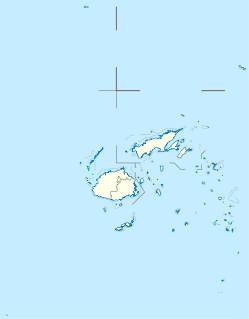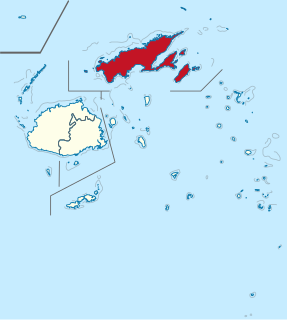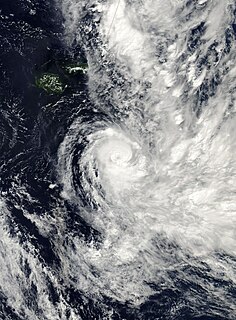Buca Bay is an isolated area on the Fijian island of Vanua Levu. The four villages within this bay are Vunikura, Loa, Buca and Tukavesi. It serves as a terminus for ferries that cross between Vanua Levu and Taveuni.

Fiji, officially the Republic of Fiji, is an island country in Melanesia, part of Oceania in the South Pacific Ocean about 1,100 nautical miles northeast of New Zealand's North Island. Its closest neighbours are Vanuatu to the west, New Caledonia to the southwest, New Zealand's Kermadec Islands to the southeast, Tonga to the east, the Samoas and France's Wallis and Futuna to the northeast, and Tuvalu to the north. Fiji consists of an archipelago of more than 330 islands—of which 110 are permanently inhabited—and more than 500 islets, amounting to a total land area of about 18,300 square kilometres (7,100 sq mi). The most outlying island is Ono-i-Lau. The two major islands, Viti Levu and Vanua Levu, account for 87% of the total population of 898,760. The capital, Suva, on Viti Levu, serves as the country's principal cruise-ship port. About three-quarters of Fijians live on Viti Levu's coasts, either in Suva or in smaller urban centres such as Nadi—where tourism is the major local industry—or Lautoka, where the sugar-cane industry is paramount. Due to its terrain, the interior of Viti Levu is sparsely inhabited.

Vanua Levu, formerly known as Sandalwood Island, is the second largest island of Fiji. Located 64 kilometres to the north of the larger Viti Levu, the island has an area of 5,587.1 square kilometres (2,157.2 sq mi) and a population of 135,961 as of 2007.

Taveuni is the third-largest island in Fiji, after Viti Levu and Vanua Levu, with a total land area of 434 square kilometres. The cigar-shaped island, a massive shield volcano which rises from the floor of the Pacific Ocean, is situated 6.5 kilometres to the east of Vanua Levu, across the Somosomo Strait. It belongs to the Vanua Levu Group of islands and is part of Fiji's Cakaudrove Province within the Northern Division.
Electricity is an uncertain factor in Buca Bay, with different villages opting for different source of power including village generator, individual private generator, solar power and Hydro.

Hydroelectricity is electricity produced from hydropower. In 2015, hydropower generated 16.6% of the world's total electricity and 70% of all renewable electricity, and was expected to increase about 3.1% each year for the next 25 years.
Most inhabitants are small farmers, or try to make a living working in other cities or villages in Vanua Levu. Buca Bay is accessible by bus from Savusavu, about 65 kilometres (40 mi) away via the Hibiscus Highway. Upgrading of the rural road was announced in 2011. [1]

Savusavu is a town in the Fijian Province of Cakaudrove. The town is located on the south coast of Vanua Levu Island and had a population of 3,372 in the 2007 census.
Opposite the bay is the island of Kioa, inhabited by Tuvaluans relocated due to overcrowding and lack of adequate food supplies on their home island. The island of Rabi is also visible from Buca Bay.

Kioa is an island in Fiji, an outlier to Vanua Levu, one of Fiji's two main islands. Situated opposite Buca Bay, Kioa was purchased by settlers from Vaitupu atoll in Tuvalu, who came between 1947 and 1983.

Tuvalu, formerly known as the Ellice Islands, is a Polynesian island country located in the Pacific Ocean, situated in Oceania, about midway between Hawaii and Australia. It lies east-northeast of the Santa Cruz Islands, southeast of Nauru, south of Kiribati, west of Tokelau, northwest of Samoa and Wallis and Futuna and north of Fiji. It comprises three reef islands and six true atolls spread out between the latitude of 5° to 10° south and longitude of 176° to 180°, west of the International Date Line. Tuvalu has a population of 10,640. The total land area of the islands of Tuvalu is 26 square kilometres (10 sq mi).

Rabi is a volcanic island in northern Fiji. It is an outlier to Taveuni, in the Vanua Levu Group. It covers an area of 66.3 square kilometers, reaching a maximum altitude of 463 meters and has a shoreline of 46.2 kilometers. With a population of around 5,000, Rabi is home to the Banabans who are the indigenous landowners of Banaba Island; the indigenous Fijian community that formerly lived on Rabi was moved to Taveuni after the island was purchased by the Banabans. The original inhabitants still maintain their links to the island, and still use the Rabi name in national competitions.
Natuvu is the site of a new clinic (The Mission at Natuvu Creek), specializing in eye, dental and non-invasive medical treatment. The clinic was scheduled to be operational in February 2008 with water and fuel service at the jetty for yachts and boats. Permanent moorings for short term stays were also planned.





